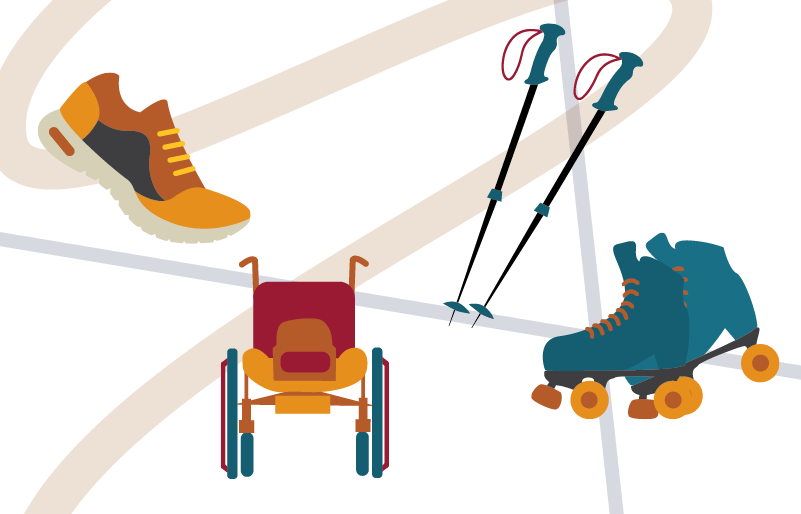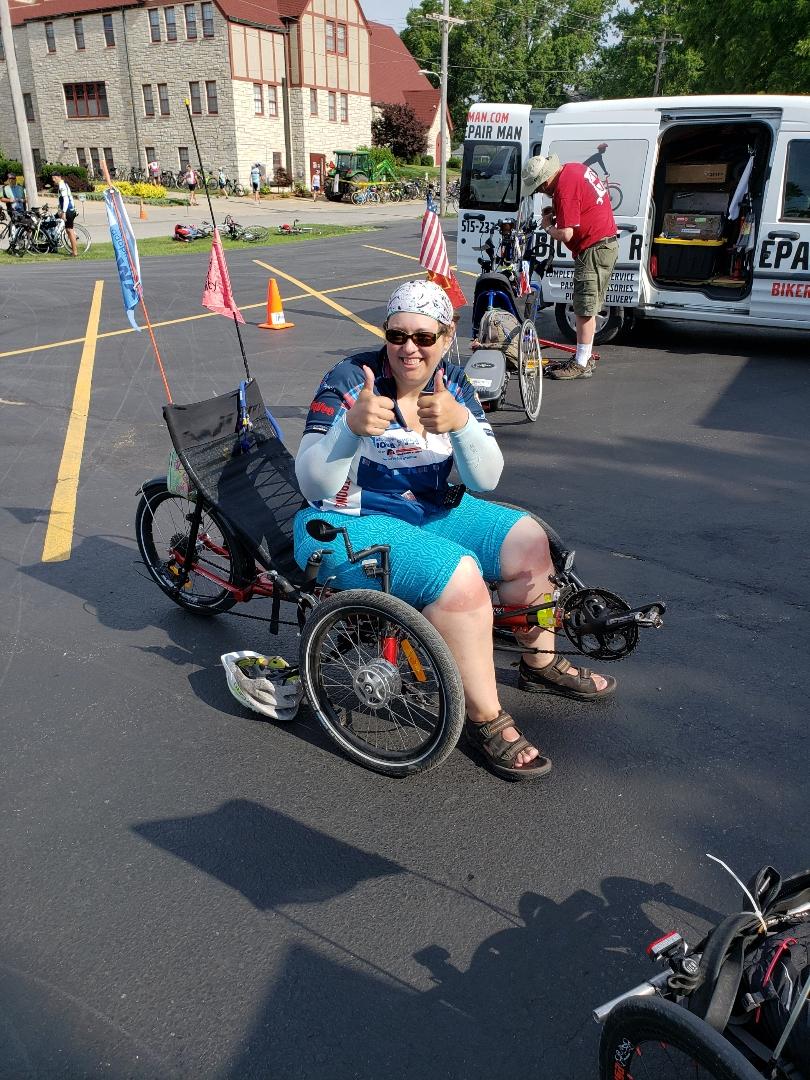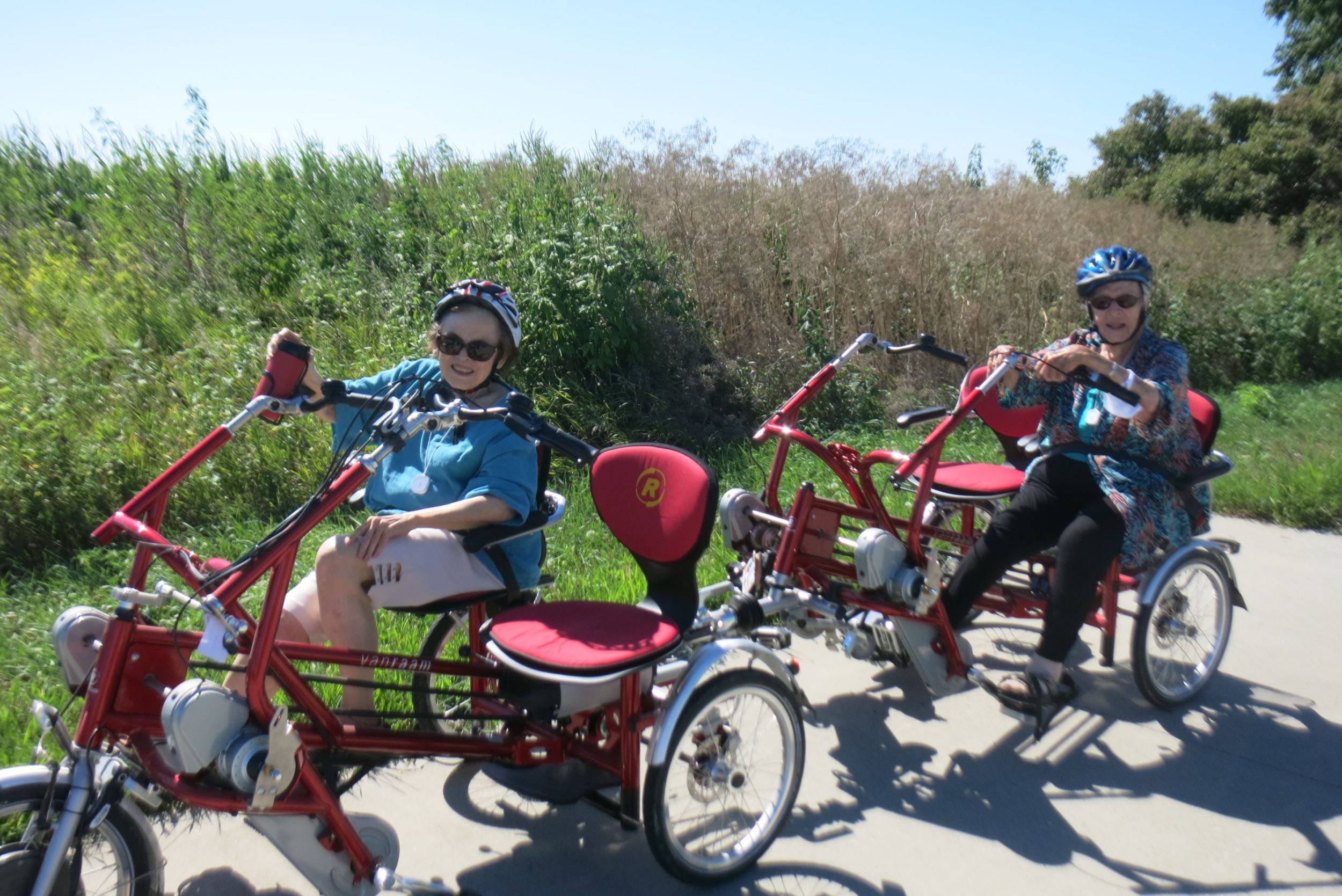Converging Trails
By Katy Heggen on February 18, 2021 in Blog
This story is part of an ongoing series, Lay of the Land, that seeks to explore the different ways people engage with nature, and how those experiences both on and off the land have informed their relationship to it. We believe that the more we understand about our own and others’ experiences on the land, the better we’ll be able to work together to protect and care for it. To view other stories in the series, visit inhf.org/about-us/publications
 It's customary for thru-hikers to assign one another trail names as they make their way from one trailhead to another. It’s less common for multi-use trail users to adapt a moniker. But there are always exceptions.
It's customary for thru-hikers to assign one another trail names as they make their way from one trailhead to another. It’s less common for multi-use trail users to adapt a moniker. But there are always exceptions.
Apocalypse Meow, Dee Flesher, Chachi, Tzenda and Skatie aren’t trail names in the traditional sense. After all, they were established indoors, not out. Nonetheless, this past year, they’ve made the transition to the trail.
The individuals they’re affiliated with belong to an ever-expanding array of Iowans who are using the trails for personal enjoyment as well as a space for staying connected, discovering and reconnecting with communities that extend well beyond the trailhead.
Crossing Over
Emilee Asher was equal parts anxious and excited the first time she attended a Des Moines Roller Derby (DMRD) meetup.
“I was terrified,” Asher said. But she left her home in Redfield and drove to the rink on Des Moines’ south side anyway. “I couldn’t even skate halfway around the track. I was shaking the whole time and getting lapped by little kids.”
But her fellow skaters cheered her on. Their support gave her the courage to attend the team’s next practice. A year-and-a-half later, Asher, aka Apocalypse Meow, is still skating and roller derby has become a fixture in her life on and off the flat track.
“I’ve made some of the best friends I’ve ever had in derby,” she said.
Last March, DMRD made the difficult decision to suspend all scheduled practices and events in the interest of slowing the spread of COVID. This left many in the tight-knit community looking for a safe way to stay connected.
“We were all really missing skating and each other,” said Katie Akin, aka Skatie, who joined the team shortly after moving to Des Moines in 2019. “So we started skating together on the trails.”
.JPG)
For many on the team, skating outdoors was an entirely new experience that brought with it a unique set of challenges ranging from contending with rocks, hills and the weather, to learning how to stop, slow down and fall on pavement.
“It’s a great way to work on different skills and a really good way to get out, see nature and other people,” said Heather Gibb, aka Dee Flesher, who’s been playing derby and trail skating since 2012.
“Skating on the trails is just relaxing,” said Tre Manken, aka Tzenda, who’s been involved with derby since 2014 and trail skates regularly. “My trail skating has always been separate [from derby], it’s never been training-orientated for me. You have the ability to look around and take in the scenery, stop at the bar and have a beer, and just enjoy it. I’ll skate all winter long as long as the trail is dry.”
Being part of a community that welcomes, affirms and embraces people of all abilities and backgrounds also appeals to many skaters.
“Everyone is just so welcoming. It doesn’t matter what size or shape you are, whether you’ve been skating forever or this is your first time,” said Asher, who was three-hundred pounds when she started skating. “As a teammate and coach, I always try to make people feel that same sense of inclusion I felt when I first started.”
.JPG)
“In roller derby there’s a spot for everyone,” said Gibb. “I think trail skating’s the same. There’s a trail out there for everyone.”
Skating on the trails has also brought to light opportunities to welcome others into the community.
“As the summer went on, we were getting more and more requests from people to join the team,” said Charissa Thornton-Raysby, aka Chachi, who’s been playing derby for several years. “We realized that there are a lot of people that want to skate.”
In response, Thornton-Raysby, Akin and another skater launched @rollerskatedesmoines, an Instagram account aimed at promoting “all things roller skating in Des Moines.”
“I like being a part of something that reaches out to people who maybe aren’t mainstream and gives them a place to belong, something to be a part of,” said Thornton-Raysby. “Trails provide another way for them to find us.”
A Different Kind of Connector
Whereas trails have provided a way for the skating community to stay connected, for Emily Medina, they facilitated an introduction to a community that is akin to family, and provided possibilities as she adjusted to a new way of moving through the world.
Medina has been cycling her whole life. She took a brief break when she was diagnosed with ataxia, a rare degenerative disease similar to multiple sclerosis that affects the nervous system. But it wasn’t long before she was back on the bike.
“After my diagnosis, my two-wheel bike went away,” said Medina. “I wasn’t able to balance it anymore. I ended up getting a recumbent trike and it was really great.”
About a year later, Medina learned about the Adaptive Sports Iowa Cycling Team, a RAGBRAI team of adaptive and support cyclists. Created in 2011 to reduce barriers to access at RAGBRAI for cyclists with physical disabilities, the team has grown exponentially in its eight years.
"We started with 24 riders," said Adaptive Sports Iowa Director Hannah Lundeen. "Now we have about 80 riders each year. The majority of our riders- about 70% - are from Iowa."
Since joining the team, Medina has completed the last seven years of RAGBRAI, riding the full river-to-river stretch. The months in-between are spent training, much of it on the trails, which offer a range of routes and a safe place to ride.

“Trikes are a bit wider, so they don’t always fit on sidewalks, so you run the risk of getting stuck in a rut. Trails are wide so you can get anywhere you want,” explained Medina. “I feel so much safer being on a trail, especially when I’m training alone. You have a lower profile on a trike. Not everyone will see you on the road.”
While Medina appreciates the independence that comes with having the option to train on her own, she revels in opportunities to ride the trails alongside her teammates and others in Iowa’s adaptive cycling community.
“There’s this sense of camaraderie. I would actually say that’s the best thing about being an adaptive cyclist. Cycling itself is probably right behind that,” Medina said. “When you’re on the trail, everyone is looking out for everybody else. If someone gets a flat, people you don’t know stop and try to help. It’s nothing like the rest of the world. It’s the world as it should be.
Trail Links
Over the years, John Brunow has taken countless cyclists of all ages, abilities and backgrounds on their very first bike ride.
“When I ask someone when the last time was they rode a bike and they tell me they’re 95-years-old and it’s their first time on a bike, it just makes my day,” said Brunow, who owns All Ability Cycles, LLC, a bike shop one block from the Raccoon River Valley Trail trailhead in Jefferson, Iowa that specializes in adaptive bikes, equipment and maintenance. “More often than not, it makes theirs, too.”
It’s the opportunity to provide experiences like these that have led an increasing number of care communities across Iowa to reach out to John about purchasing bikes for their residents.
“Our bikes get A LOT of use,” said Spencer Steffy, director of programming at NewAldaya Lifescapes, a retirement and assisted living community in Cedar Falls.
NewAldaya purchased two bikes – a side-by-side tandem and a wheelchair accessible model – two-and-half years ago, and haven’t stopped using them since.
“If it’s over 55 degrees, we’re out on those bike from 9 a.m. until 4 or 5 in the afternoon every day of the week," Steffy said.
“The bikes have been so beneficial,” said Diane Watts, activity director at Spurgeon Manor, a continuing care retirement community in Dallas Center. Spurgeon Manor purchased two bikes, a side-by-side tandem and a wheelchair accessible bike three years ago. “They get people out of the building, into the fresh air and sunshine, which is a great sensory experience. There are the social benefits of being out in the community. It’s good for their memory, too. They remember the days they get to go on a bike ride.”
Between serving a wide range of residents with differing levels of mobility and the centers’ proximity to nearby trail corridors – NewAldaya the Cedar Valley Trails system and Spurgeon Manor the Raccoon River Valley Trails system – both Watts and Steffy say the bikes were kind of a no brainer.
“The activity department makes sure that everyone that likes to be outside gets to go for a ride,” said Mavis Jensen, a resident at NewAldaya. “Whether they pedal or don’t pedal, are in a wheelchair or not, they still get to go.”
“I help pedal,” added Jensen, 91, who uses the tandem bike often. “I feel like I need the exercise.”
But for Jensen, adaptive cycling and access to trails have provided much more than a bit of exercise and the opportunity to get outdoors. They’ve offered her a chance to reconnect with a part of life that she thought was in the past and through it, her community, especially during the pandemic.
“I used to be a cyclist, but got rid of mine [my bike] a few years ago,” she said. “It’s just a good feeling to get outside, ride the trails, see people and new things. It feels good when you get back in, too.”
“Seeing other cyclists, having conversations, exchanging waves – that’s a big thing, just normalizing social actions,” said Brunow, who’s also sold adaptive bikes to individuals, families and organizations throughout Iowa and beyond.
“Inclusive cycling isn’t just about equipment and having places to go ride, it’s about being part of the community,” he said.
Trails for All
Trails are often synonymous with connection. Connections to neighboring towns, the outdoors, economic opportunities… But the impact of connections forged on the trail – in our individual and collective communities – are immeasurable.
In the last 40 years, Iowa Natural Heritage Foundation (INHF) has helped create more than 2,000+ miles of multi-use trails across Iowa. Many trails cited as favorites of those featured here, including the High Trestle Trail, the Raccoon River Valley Trail and the Great Western Trail, are projects INHF has played an integral part in.

As INHF continues to help communities across the state create and connect trails, we look forward to learning more about the many ways people use Iowa’s multi-use trails, and the impact those trails have had on them and the way they relate to Iowa’s outdoors and each other.
“I really don’t know how to explain it any other way,” said Jensen. “It makes you feel like you’re part of something. It’s just a good ride.”
Editor’s note: Sometimes the hardest part of getting outdoors is finding a community to do it with. If you are part of or know of groups welcoming people outdoors, please consider sending us a note so we may consider uplifting them here and in other INHF communications. Emails may be sent to Editor Joe Jayjack at jjayjack@inhf.org